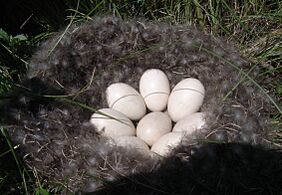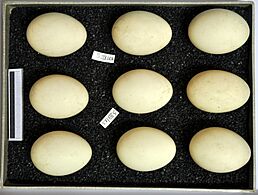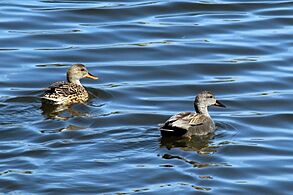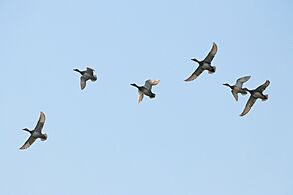Gadwall facts for kids
Quick facts for kids Gadwall |
|
|---|---|
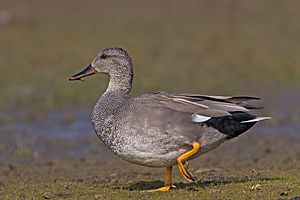 |
|
 |
|
| Female | |
| Conservation status | |
| Scientific classification | |
| Genus: |
Mareca
|
| Species: |
strepera
|
| Subspecies | |
|
|
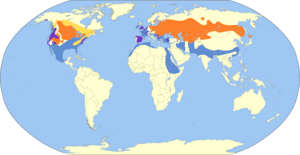 |
|
| Synonyms | |
|
|
The gadwall (Mareca strepera) is a type of duck that lives in many parts of the world. It's known as a "dabbling duck" because it mostly feeds by tipping its head into the water. Gadwalls belong to the Anatidae family, which includes ducks, geese, and swans.
Contents
About the Gadwall's Family Tree
The gadwall was first officially named by a famous scientist named Carl Linnaeus in 1758. He wrote about it in his book, Systema Naturae.
Scientists have studied the DNA of ducks. They found that the gadwall is very closely related to the falcated duck. These two ducks are also close relatives of the three types of wigeons. All of these ducks are now grouped together in a scientific family called Mareca.
There are two main types, or subspecies, of gadwalls:
- M. s. strepera: This is the common gadwall that Linnaeus first described.
- M. s. couesi: This type, called Coues's gadwall, is sadly extinct. It disappeared around 1874. These ducks used to live only on Teraina, a small island in the Pacific Ocean.
The scientific name strepera comes from a Latin word meaning "noisy." We don't know for sure where the name "gadwall" came from, but people have used it since 1666.
What Gadwalls Look Like
Gadwalls are about 47–58 cm (19–23 in) long. Their wings can spread out to about 78–85 cm (31–33 in). Male gadwalls are a little bigger than females. Males weigh around 990 g (35 oz), while females weigh about 850 g (30 oz).
When breeding, male gadwalls are mostly grey. They have a black rear end and reddish-brown patches on their wings. They also have a bright white patch on their wings called a speculum. You can easily see this white patch when they fly or are resting.
When males are not breeding, their feathers change. This is called "eclipse plumage." They look more like females but still have the male wing pattern. They are also usually greyer on top.
Female gadwalls are light brown. Their feathers look a lot like a female mallard duck. You can tell them apart because female gadwalls have a bill with dark orange edges. They are also smaller and have a white speculum and a white belly. Both male and female gadwalls change their feathers twice a year.
Gadwalls are usually quiet ducks. But they do make sounds during their courtship display. Female gadwalls make a sound like a mallard's "quack," but it's higher pitched. Males make a grunt sound, like "mep," and a whistle.
Where Gadwalls Live and Travel
Gadwalls breed in northern Europe and across Asia. They also breed in central North America. In North America, you can find them breeding near the Saint Lawrence River and the Great Lakes. They also live in places like Alberta, Saskatchewan, the Dakotas, and as far south as Kansas. You can also find them along the Pacific coast of Canada and southern Alaska. It seems like more gadwalls are starting to live in eastern North America.
These ducks are migratory. This means they fly south for the winter. They travel from coastal Alaska all the way down to Central America. They also fly east to places like Idaho, Kansas, Ohio, and Virginia.
In Great Britain, gadwalls don't breed very often, but many visit in winter. Their numbers have grown in recent years. This might be because some were brought there by people. Also, some ducks from other parts of Europe might have decided to stay and breed in Scotland. In Ireland, a small group has started breeding. You can find them in County Wexford and Lough Neagh. Gadwalls are also seen in parts of South Asia, especially southern India.
Gadwall Behaviour and Life Cycle
The gadwall likes open wetlands. These include places like prairie lakes, wet grasslands, or marshes with lots of plants around the edges. They usually find food by "dabbling." This means they tip their head into the water to eat plants. They can also dive underwater for food, which they are better at than other dabbling ducks. Sometimes, they even take food from diving birds like coots!
Gadwalls build their nests on the ground. Often, their nests are a bit away from the water. Unlike some other ducks, gadwalls don't usually form very large groups when it's not breeding season. They tend to stay in smaller flocks.
Gadwalls are monogamous, meaning one male and one female stay together. They might start breeding after their first year. Pairs often form during their fall migration or when they arrive at their breeding grounds. Sometimes, they even pair up in August.
As mentioned, gadwalls are generally quiet. But during courtship, the male makes a "mep" call. He does this during a display called the "burp," where he lifts his head and points his bill towards a female. Another display is the "grunt-whistle." The male raises his head, dips his bill into the water, and splashes water droplets towards a female. As he lifts his bill, he makes a loud whistle followed by a low "burp."
Young gadwalls eat insects when they are little. Adult gadwalls also eat some snails and insects during the nesting season.
Conservation Efforts
Right now, the gadwall is listed as "least concern" on the IUCN Red List of Threatened Species. This means that scientists are not worried about them becoming extinct soon. The gadwall is also part of an agreement called the Agreement on the Conservation of African-Eurasian Migratory Waterbirds (AEWA). This agreement helps protect migratory waterbirds.
The number of gadwalls has been growing. Their population increased by about 2.5% between 1966 and 2010, and it continues to rise. Gadwalls are one of the most hunted duck species. They are third after the mallard and green-winged teal, with about 1.7 million shot each year.
Thanks to groups like Ducks Unlimited and Delta Waterfowl Foundation in the United States and Canada, gadwalls are hunted in a way that keeps their numbers healthy.
Images for kids
-
Female and male, WWT London Wetland Centre, Barnes
-
Male and female on the Lake Ontario



